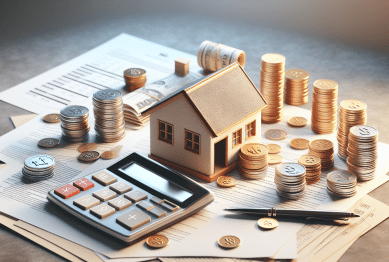Ever wondered how to access your home’s value without selling? This guide reveals practical home equity options, funding strategies, and what industry trends mean for homeowners looking to make confident decisions.
Understanding Home Equity: The Foundation of Your Wealth
Home equity is the portion of your property you truly own. It’s built up as you pay down your mortgage or as property values increase. Many homeowners are surprised to learn the value sitting quietly in their homes. For countless families, this built-in asset can offer a financial cushion or the opportunity to fund future plans. But how is home equity calculated? Start by subtracting your outstanding mortgage balance from your home’s current market value. The remainder represents your real stake in the property. Recognizing this figure is the first step in making informed choices about financial strategies tied to real estate. In today’s housing market, understanding this number gives peace of mind. It also unlocks potential opportunities for consolidating debt, investing in improvements, or simply enjoying extra savings.
Homeowners often ask whether their equity is ‘real’ if they’re not planning to sell. But equity has real-world uses and can be accessed through several mechanisms. While markets can fluctuate, housing continues to perform as a foundational asset in people’s portfolios. Many industry experts highlight home equity as a safe harbor during uncertain economic times. That’s why knowing what portion of your home you own, in comparison to your remaining loan, can steer you toward practical financial decisions for both the near and distant future. Use home equity wisely, and it could provide leverage or create flexibility in ways that other investments cannot.
There’s more than one way to tap into your property’s value. Banks and lenders have created a variety of options, each with unique benefits and eligibility criteria. Understanding the value of your equity empowers you to select the most suitable path should you need funds for renovations, education, or other significant expenses. Over time, your equity can increase through home improvements and rising local property values. Factoring in interest rates and overall housing trends lets you develop a long-term vision for your asset. Making smart choices about your home equity today can shape financial stability tomorrow.
Home Equity Loans Versus HELOCs: Navigating Funding Choices
When considering how to access funds tied to real estate, two popular options emerge: home equity loans and home equity lines of credit (HELOCs). Home equity loans provide a lump sum with a fixed interest rate, making budgeting predictable. These funds are repaid over a set term, often with stable monthly payments. In contrast, a HELOC acts more like a credit card, letting homeowners borrow as needed up to a maximum approved amount. Interest usually only applies to the amount drawn, not the full limit. These differences matter. Fixed home equity loan payments suit those with a single large expense, while HELOCs can benefit those who want flexibility for ongoing projects or potential emergencies.
Applications for both options involve a review of your equity, credit score, and income. Lenders want to minimize risk, typically allowing you to borrow up to 80% of your home’s appraised value minus what’s still owed. Some banks offer lines with introductory low rates, but those can adjust upward, so it’s important to review terms. Regulations also require clear disclosures, so you can compare features—including draw periods, repayment schedules, and closing costs—before deciding. Making these comparisons will help clarify whether the certainty of a loan payment or the convenience of a revolving line better fits your needs. Always read the details; small differences can have long-term impacts.
Both funding mechanisms have strategic uses. Home equity loans work well for consolidating debt or making a large purchase, while HELOCs support home improvements that may happen in phases. Tax benefits can sometimes apply, especially if funds support home renovations, so it’s worth asking a financial advisor or reviewing IRS rules (https://www.irs.gov/taxtopics/tc505). Responsible use of either option keeps your home at the heart of your financial planning, providing access to significant capital while preserving ownership.
Reverse Mortgages: A Specialized Option for Seniors
Reverse mortgages are designed for older homeowners seeking to supplement income without selling their homes. Available to those aged 62 and up, these products let borrowers convert a portion of equity into tax-free cash, often with flexible disbursement options. Instead of making monthly payments, the loan balance grows over time and is repaid when the home is sold or the owners move out. This can provide retirees with much-needed liquidity, especially for covering medical bills, home modifications, or daily expenses. The concept is appealing for aging in place, but it’s important to evaluate the fees and interest that accumulate over the life of the loan (https://www.consumerfinance.gov/consumer-tools/reverse-mortgages/).
Reverse mortgages aren’t right for everyone. They may reduce the potential inheritance for heirs and can complicate long-term estate plans. It’s crucial to seek counseling, which is often required as part of the application process, to ensure both homeowners and families understand obligations. Some states and non-profit agencies provide guidance to help people decide whether a reverse mortgage aligns with their life goals and financial landscape. Deceptive advertising has led to regulatory oversight, with up-to-date resources widely available through federal agencies and consumer advocacy groups. Knowledge is protection when it comes to complex financial products.
Despite potential drawbacks, reverse mortgages remain a vital tool for households with high equity but limited cash flow. For those who qualify, the flexibility to access cash without monthly repayments can mean the difference between a stressful retirement and a comfortable one. Reviewing guidance from entities like the AARP or the HUD helps clarify the responsibilities that come with these loans and demystifies the process for interested seniors and their families (https://www.aarp.org/money/credit-loans-debt/info-2020/reverse-mortgage-facts.html).
Cash-Out Refinancing: Balancing Debt and Opportunity
Cash-out refinancing replaces your existing mortgage with a new, larger one, letting you receive the difference in cash. Often used for funding major projects or paying down high-interest debts, this strategy has seen increased interest as home values rise. Qualifications depend on your creditworthiness, current loan terms, and home appraisal. While cash-out refinancing can provide significant sums at competitive interest rates, it involves resetting your mortgage timeline and may introduce new costs. Savvy homeowners use online calculators and lender disclosure forms to preview costs before starting the application process (https://www.consumer.ftc.gov/articles/0151-home-equity-loans-and-credit-lines).
One of the benefits of cash-out refinancing is predictability. Generally, these loans have fixed rates and payments, which simplifies budgeting. Some people use the cash to renovate or upgrade energy systems, which can potentially increase property value even more. However, extending your repayment timeline could mean paying more interest over time, particularly if the loan is for a longer term. Market changes also play a role—if home values decrease or rates rise, refinancing may become less attractive, highlighting the importance of monitoring trends and reassessing plans as needed.
Choosing between a home equity loan, a HELOC, or a cash-out refinance depends on your comfort with debt and long-term goals. Because your home is the collateral, missed payments can result in foreclosure risks. As a result, experts emphasize borrowing only what’s needed—never more. These financial products give access to your equity without moving, letting you manage investments, education expenses, or life transitions with greater confidence. Detailed research and speaking to lenders or housing counselors can help ensure your strategy is aligned with your financial well-being.
Shared Equity and Sale-Leaseback Models: Fresh Thinking for Modern Households
Innovative models have emerged for unlocking equity. Shared equity agreements allow homeowners to exchange a portion of future home appreciation for upfront cash, often through investors or specialized companies. With this route, households gain access to funds without assuming new debt or monthly payments. As the home’s value climbs, investors share in any gains at the point of sale or refinancing. This approach can increase cash flow, reduce risk, and offer appealing flexibility for those who can’t or don’t wish to take on debt. It’s essential to read all terms closely and consider how future price changes may impact both parties (https://www.urban.org/urban-wire/understanding-shared-equity-housing-models).
Sale-leaseback programs are another trending option. Here, a company or investor purchases your house, then rents it back to you so you remain as a tenant. This model provides immediate access to full equity without requiring a move. While it offers a unique way to free capital, sale-leasebacks also come with lease agreements that dictate terms and rights. Homeowners must consider future rent increases, potential loss of ownership, and how eviction protections apply. Industry advocacy groups recommend comparing sale-leaseback contracts carefully against other equity access options to ensure they fit household needs and outlook.
Both approaches cater to changing preferences in today’s real estate landscape. They support homeowners who fall outside conventional lending, or who want to maintain flexibility in life and finances. Shared equity models especially benefit those in rapidly appreciating markets, while leaseback agreements can be attractive for those needing maximum liquidity. With plenty of fine print, careful tax and legal consultation is encouraged before signing. Modern solutions for equity unlock are reshaping how people use their homes as a financial springboard.
Guidance for Safe Decision-Making: Protecting Your Home and Future
No matter which route homeowners choose, safety and transparency are paramount. Government agencies like the Consumer Financial Protection Bureau provide tools to help compare loans, understand disclosures, and flag predatory terms (https://www.consumerfinance.gov/owning-a-home/). Credit counseling services and nonprofit organizations also offer unbiased advice, especially for first-timers unsure where to start. Taking the time to review all options—along with their costs, risks, and long-term impacts—prepares you to make decisions that truly support personal and family goals.
Staying informed about the housing and lending environment is crucial. Regulatory updates, interest rate movements, and neighborhood trends can all change the landscape overnight. Trusted real estate agents, loan officers, and independent advisors often have up-to-date insight and can help compare products or strategies. Safeguarding your equity means understanding the full picture, from the initial application process to repayment or resale. Homeowners gain the most when they view borrowing and lending arrangements as tools supporting—not controlling—their lifestyles and dreams.
Finally, beware of offers that seem too good to be true. Aggressive sales tactics or quick-cash promises may mask costly fees or risky terms. Seeking multiple opinions, reading consumer reviews, and using government resources all contribute to a safer, smarter experience. With preparation and empowerment, your home equity can truly serve as a foundation for both security and opportunity.
References
1. U.S. Department of Housing and Urban Development. (n.d.). Home Equity Conversion Mortgages for Seniors. Retrieved from https://www.hud.gov/program_offices/housing/sfh/hecm/hecmhome
2. Consumer Financial Protection Bureau. (n.d.). Reverse Mortgages. Retrieved from https://www.consumerfinance.gov/consumer-tools/reverse-mortgages/
3. Federal Trade Commission. (n.d.). Home Equity Loans and Credit Lines. Retrieved from https://www.consumer.ftc.gov/articles/0151-home-equity-loans-and-credit-lines
4. Urban Institute. (2019). Understanding Shared Equity Housing Models. Retrieved from https://www.urban.org/urban-wire/understanding-shared-equity-housing-models
5. Internal Revenue Service. (n.d.). Home Mortgage Interest Deduction. Retrieved from https://www.irs.gov/taxtopics/tc505
6. Consumer Financial Protection Bureau. (n.d.). Owning a Home Tools and Resources. Retrieved from https://www.consumerfinance.gov/owning-a-home/









